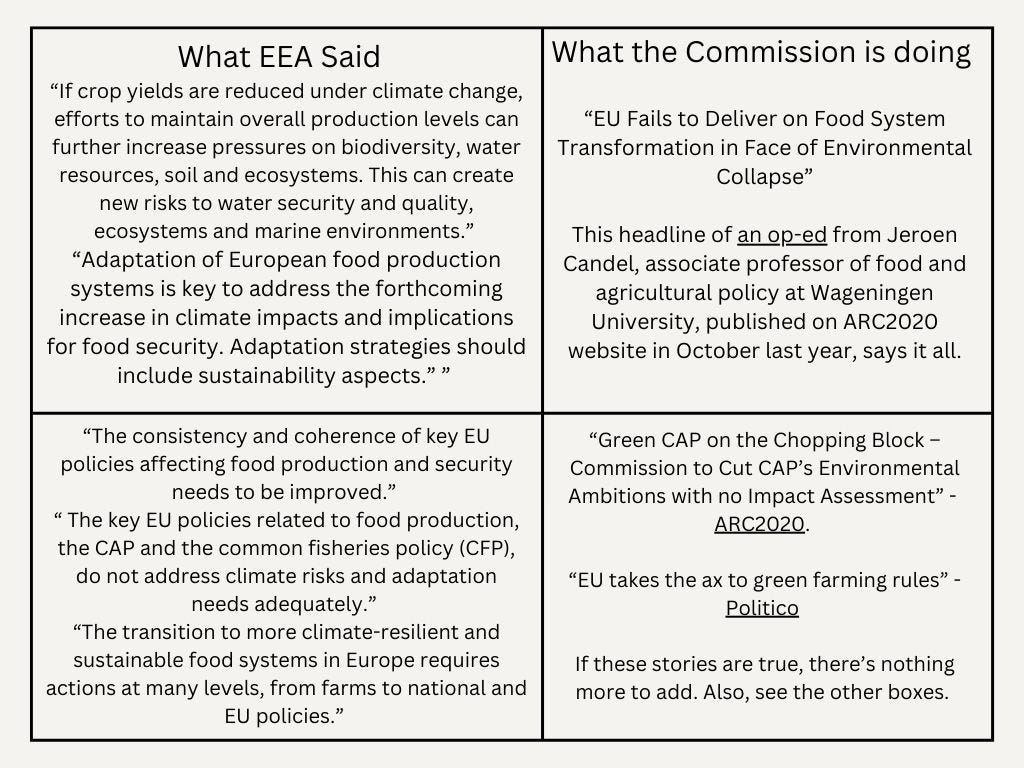Welcome To The Upside Down
Only this time, we are willing participants in a plot to destroy ourselves
In the super-popular Netflix series Stranger Things, the Upside Down is a parallel dimension full of terrifying and bloodthirsty monsters that are intent on entering our world and - based on what we can gather from four seasons of scares - destroy us.
Well, I’m calling our current world “Upside Down” because policy decisions and our own behaviour seem to suggest we are participating in our own demise.
This week’s title isn’t just about name-dropping a cool show though. It’s also my way of saying, “What in the flying %$#! are we doing?”
The Hot Ones
Europe is the fastest warming continent in the world and its food systems are unprepared for the rapidly growing risks of climate-induced disasters such as megadroughts, the European Environment Agency (EEA) said in its first ever European Climate Risk Assessment, published on Monday.
The continent has warmed about twice the global rate since the 1980s and is “facing more and stronger climate hazards, including heatwaves and prolonged droughts, heavy precipitation leading to pluvial and fluvial floods, and sea level rise leading to coastal floods,” it said. The full report is here. Food is on pages 86-99.
“Further climate impacts on food production within and outside Europe can create critical risks for food security within the continent by mid-century,” the report added.
Currently, about 7% of the continent’s population, mostly those belonging to disadvantaged groups, suffers from chronic hunger, according to the FAO. But this number could rise by 1.3% to 4.8% due to climate change alone, said EEA.
At the moment, Europe is self-sufficient in most food commodities, but imports a fair number of produce and inputs. These include seafood products, fruits and nuts, oilseeds, coffee, spices, fertiliser, and natural gas. So it is sensitive to shifts in both production and prices of food and feed.
In terms of specific regions, Southern Europe is “particularly at risk” from increased impacts of heat and droughts, threatening the productivity of staple crops, fruits and vegetables. This could push up food prices.
Higher temperatures also pose challenges to storage and transport of fruits and vegetables, which are exported to many other parts of Europe. The region is also susceptible to plant pests.
But other areas won’t escape unscathed either. Water scarcity is a major concern, and agriculture is already the largest net water-using sector in Europe, with several countries exceeding thresholds for sustainable use, the report said.
“Increased efforts are urgently needed to manage the risk of prolonged drought, including in the common agricultural policy (CAP) strategic plans of the Member States… An analysis of the current CAP strategic plans indicates considerable room for further improvement.”
You would think that such language will force policymakers to sit up and listen. Well, literally two days after the EEA’s assessment came out, news broke (via a leaked document) that the European Commission is planning to “slash environmental requirements for farmers”.
“The proposals, seen by POLITICO, would end a requirement to set aside land to promote biodiversity, making it and other measures — such as minimising tillage to prevent soil erosion — voluntary. Taken together, they would enable farmers to get EU subsidies even if they don't meet the most basic environmental standards,” wrote Politico’s Bartosz Brzeziński.
That crashing sound you just heard? That’s my face hitting the keyboard, struck by the sheer incredulity of the decision.
The Politico article is based on a leak and the Commission has yet to publish its proposal, even though that was supposed to have happened earlier today (Friday, Mar 15). So I don’t know if the rollback is really happening, but experience says it is very possible.
So below is a short exercise of what the EU’s own scientists have said and what the Commission is actually doing.
Can We Reach “Peak Livestock”?
We’ve heard about the need to reach “peak oil”, “peak fossil fuels”, and “peak deforestation”. Now scientists are talking about the need for “peak livestock”. Why?
Because “continued growth in this sector” will make it impossible to reduce greenhouse gas emissions and “jeopardise deforestation and land restoration targets”, said a new paper from Harvard Law School, which is based on responses from over 200 climate scientists and sustainable food/agriculture experts based in 48 countries. Almost two-thirds of the respondents were IPCC authors.
With food systems accounting for a third of global man-made emissions, and livestock production alone responsible for about half of that amount, it is quite crucial that we find ways to slash these numbers.
We already know that livestock contributes to methane, a GHG that has a shorter lifespan in the atmosphere than CO2 but is significantly more potent, but cattle production “is the single largest direct cause of deforestation, and animal agriculture is also a major indirect cause due to land use change for feed crop production”, said the paper.
Yet, only 12 countries from the 175 signatories to the Paris Agreement (174 countries plus the EU) have pledged to reduce GHGs from their livestock sectors, it added. So the four authors of the Harvard paper asked experts what and how to tackle this.
Most experts (92%) agree that reducing emissions from the livestock sector is important to limit temperatures to a maximum of 2°C above pre-industrial levels.
35% agree that emissions from livestock must peak before 2025 in high-income countries.
78% think it’s important for absolute livestock numbers to peak globally by 2025.
Nearly 60% agree that cutting the consumption of livestock products have the potential to contribute significantly to meeting emission reduction targets. Reducing the number of animals came second, followed by other actions. See second graph below.
The European Environment Agency report above said similar stuff:
“A partial shift from animal-based to plant-based food, as foreseen under the Farm to Fork Strategy and in line with international dietary guidelines, can reduce freshwater consumption for food production, as well as dependency from feed sourced outside Europe.”
“A reduction of animal production and meat and dairy consumption both in Europe and worldwide could substantially increase cereal availability for human consumption, thus enhancing food security.”
How the U.S. meat industry pushes a pro-meat narrative
But if you’re wondering why governments are so reluctant to tackle this topic (or) why this seems to be such a hot potato issue, it might be because the deep-pocketed meat industry has very loud cheerleaders.
We’ve seen this before with fossil fuel and tobacco companies. When evidence emerged of the harm their products cause to human health and the environment, they look for ways to suppress the evidence, fund their own “science” that comes up with friendlier findings, and go on a campaign blitz to confuse consumers and lobby politicians.
This new study, which came out at the end of February in the peer-reviewed journal Climate Change, looked at how the U.S. animal agriculture companies did something similar with two academic researchers: Dr. Frank Mitloehner who runs the CLEAR Center at the University of California, Davis, and Dr. Kimberly Stackhouse-Lawson, a former student of Mitloehner and former chief sustainability officer of JBS USA (a subsidiary of JBS S.A., the world’s largest meat company) who now runs AgNext at Colorado State University.
If you’re a reader of the New York Times, you may already have come across their 2022 exposé of Mitloehner and his industry links. He has also been pushing for GWP*, to be used as a metric to measure methane. The metric has been called “Fuzzy Methane Math” by a Bloomberg reporter and I’ve also written about the concerns around its use.
But this latest study provides a detailed look into how the centres started, who funded them, how the industry has worked to portray these two as “experts” and what policies they have been advocating since. They pointed out that both researchers:
have received significant research funding from industry groups
lead university centres that receive funding from industry groups
have been employed by an industry group as consultants
have received awards or travel from industry groups
have failed to disclose industry funding in instances where it is the norm to do so
have testified before US Congress
have presented to policymakers at an industry-sponsored event
have work that was referenced in public comments submitted by industry groups to regulatory agencies
have co-authored publications with industry employees
have published repeatedly in industry-funded journals
have been referenced by industry groups in industry advertisements
have published traditional and social media in support of industry interests
have minimised the industry’s role in climate change
have challenged the need for regulations or promoted policy changes in ways that are favourable to industry.
A key point the study made is that this isn’t just about potential bias resulting from these industry links but that the impacts could go deeper because of the time these researchers spend on public relations and political advocacy. Between them, they have given hundreds of presentations to state agencies, government officials, and industry groups, travelled internationally to share their views, and been cited by the U.S. media as “experts”.
Speaking of, it seems the U.S. media has been failing to keep up its watchdog role, either by accepting advertising from the meat companies - check out this recent issue of HEATED - or for failing to disclose the industry’s role in some of these narratives.
They may be the two most prominent examples but they are by no means the only ones. Marion Nestle has an ongoing column about studies funded by the meat industry - this one seems particularly blatant - and WIRED wrote about how Big Beef is already wooing science teachers at U.S. schools to reach the younger generation.
Obesity is now the most common form of malnutrition
From 1990 to 2022, obesity rates among children and adolescents worldwide quadrupled and obesity rates among adults more than doubled, while rates of underweight fell among all three groups, said a global analysis published in The Lancet.
More than one billion people in the world (159 million children and adolescents and 879 million adults) are now living with obesity, added the study, conducted by the NCD Risk Factor Collaboration, a worldwide network of over 1,500 researchers and practitioners.
In 2022, Tonga and American Samoa had the highest prevalence of obesity for women and American Samoa and Nauru for men. There, more than 60% of the adult population were living with obesity.
In the same year, the obesity rate for women in the UK was 28.3% and 26.9% for men. This is a sharp rise from 1990 when the rates were 13.8% in women and 10.7% for men.
In the U.S., the rates are 43.8% for women (21.2% in 1990) and 41.6% for men (16.9% in 1990).
Even in Italy, which prides itself as consumers of the healthy Mediterranean diet, obesity rates have inched up for both men and women (nearly 20%), even if at a slower pace than elsewhere. The rates seem stable for boys and girls, although at between 20% to 30%, it’s not really time to celebrate. Check out the supplementary materials for more details on individual countries.
We used to think obesity was a rich world’s problem and a sign of prosperity - where I come from, there’s a saying to the effect of “You’ve grown bigger and more beautiful” - but those days are long gone. These days, it is often a sign of insufficient nutrition, bad diets and a precursor to many health problems and diseases.
This doesn’t mean we should stop trying to reduce underweight, because there are still countries that are suffering from the double burden of both obesity and underweight, but it does underscore the need to come up with more effective measures to tackle obesity.
The authors used BMI to measure the extent and distribution of body fat and while they acknowledge it’s not a perfect indicator, it is one that is used widely, which makes it possible to conduct these kinds of analyses.
Thin’s Pickings
Fertile Deception - Africa Uncensored
This three-part documentary from fantastic Kenyan reporters looked into how unscrupulous folks, including perhaps those at some state institutions, sold sand as organic fertiliser to unsuspecting farmers.
Food as a weapon in the new age of starvation - Devex
Colum Lynch on how “hunger and starvation have become a standard weapon in combatants’ war arsenal, aimed at denying the enemy access to basic humanitarian supplies and undermining popular morale”.
Culinary Diplomacy - Wordloaf
Amy Halloran’s lovely and inspiring interview with Olia Hercules, a London-based Ukrainian chef and cookbook author. If you, like me, have little clue about Ukraine cuisine, this piece is a great place to start.
As always, please feel free to share this post and send tips and thoughts on mastodon @ThinInk@journa.host, my LinkedIn page, twitter @thinink, or via e-mail thin@thin-ink.net.










Many thanks Sayama Thin.
Such important realities. We need to know, and to act.